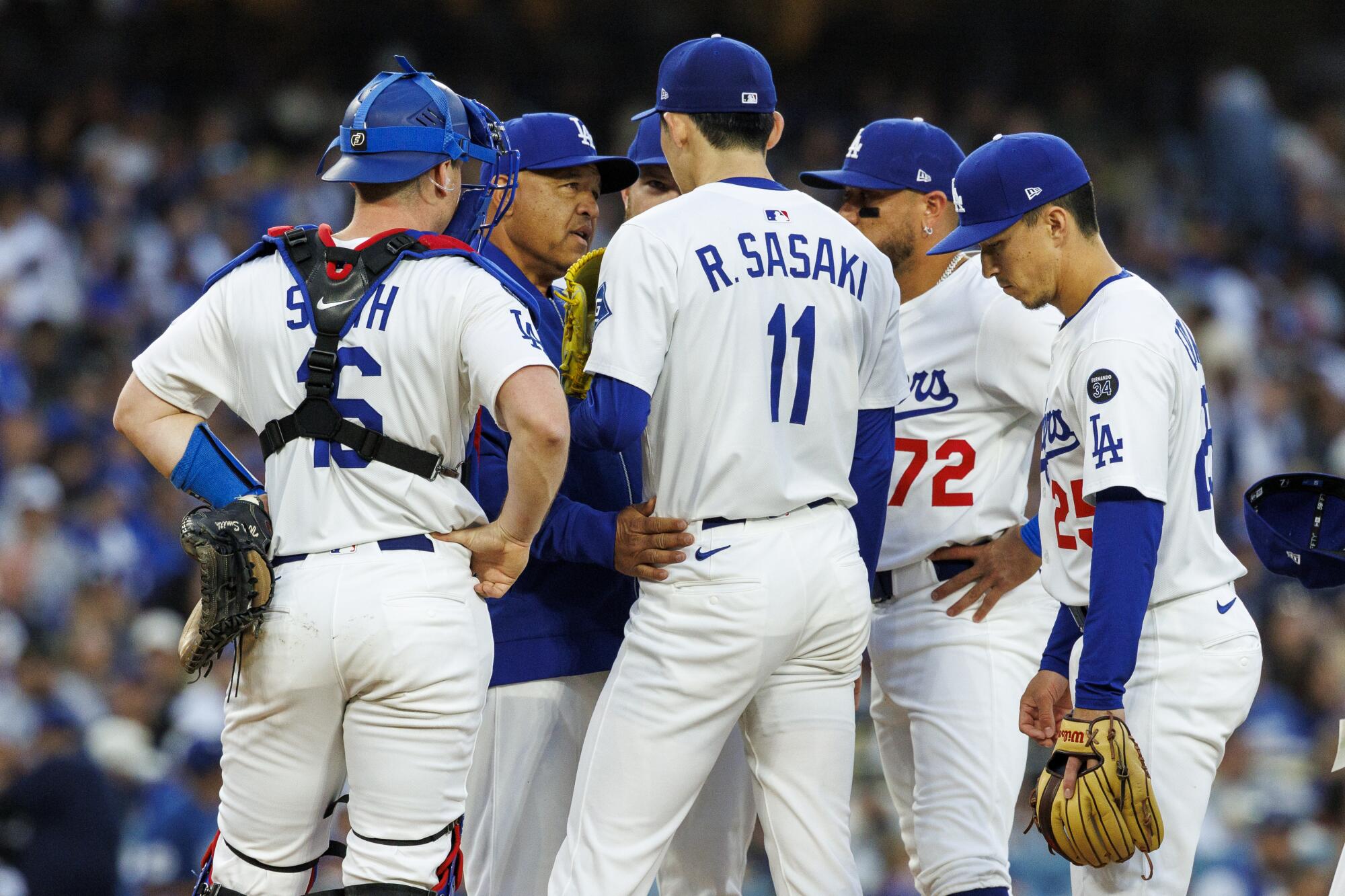The sports world is often filled with stories of young athletes rising to the occasion, but sometimes, even the most talented individuals face setbacks that challenge their confidence and growth. Roki Sasaki, one of the most highly anticipated pitching prospects to come from Japan in recent memory, has been dealing with a difficult stretch since joining the Los Angeles Dodgers. Recently, Dave Roberts, the Dodgers’ manager, spoke candidly about the struggles of Sasaki and the impact it’s having on the young pitcher’s psyche.
Sasaki’s journey from Japan to Major League Baseball has been one of great expectations. Known for his dazzling fastball and devastating splitter, he was viewed as the next big thing when the Dodgers secured his services. However, after a string of disappointing performances, questions about his future with the team have begun to swirl. “He’s upset,” Roberts said in an interview after Sasaki’s most recent struggles. “You can tell that Roki is frustrated and disappointed with his performance.”
This statement reflects not just Sasaki’s current struggles, but also the weight of expectations placed on him. Being touted as one of the brightest prospects in international baseball, the pressure to deliver on that potential has been immense, especially given the Dodgers’ long history of success and high standards.
In this article, we will take a closer look at Roki Sasaki’s struggles with the Dodgers, his background, the expectations surrounding him, and what this means for his future both in Los Angeles and in Major League Baseball as a whole.
The Arrival of Roki Sasaki in Los Angeles
Roki Sasaki arrived in Los Angeles as a highly sought-after pitching prospect, having made a name for himself as a teenage phenom in Japan’s Nippon Professional Baseball (NPB). His impressive performances for the Chiba Lotte Marines had earned him comparisons to some of Japan’s all-time greats, and scouts were enamored with his combination of velocity, movement, and control. With a fastball that can touch 100 mph and a devastating splitter that baffled hitters in Japan, Sasaki was seen as a rare talent with the potential to dominate in the Major Leagues.
After years of dominating in the Japanese league, Sasaki’s decision to make the jump to MLB was met with excitement by Dodgers fans and players alike. With the Dodgers already boasting one of the strongest rosters in the league, Sasaki was expected to slot into their already stellar pitching rotation and quickly make a significant impact.
From a talent perspective, Sasaki appeared to have all the tools to succeed at the highest level. The Dodgers, known for their ability to develop and nurture young talent, were seen as the perfect environment for Sasaki to thrive. Expectations were sky-high, but as is often the case in sports, the road to success isn’t always linear. The struggles Sasaki has faced recently have raised concerns among both fans and the front office, leading to discussions about what the future holds for him.
Sasaki’s Struggles with the Dodgers
Despite the immense talent that Sasaki brings to the table, the transition to Major League Baseball has been more difficult than anyone anticipated. In his early outings with the Dodgers, Sasaki showed flashes of brilliance, with a dominating fastball and sharp movement on his pitches. However, consistency has been an issue, and his recent performances have been disappointing, to say the least.
Sasaki has struggled with control issues, which have been the root cause of many of his problems. While he’s still able to get swings and misses, the lack of command over his pitches has often led to walks and hard-hit balls. This lack of control has been particularly problematic when facing top-tier hitters in the Major Leagues, who are more patient and selective at the plate than those in Japan.
Another issue that has plagued Sasaki’s game has been his inability to maintain his velocity throughout the course of games. Early in his outings, he can still hit 100 mph on the radar gun, but as the game progresses, his fastball loses some of its zip. This drop in velocity can be attributed to a few factors: fatigue, adjustments made by opposing hitters, and perhaps a learning curve in adjusting to the MLB schedule and workload.
Sasaki’s mental state has also been a topic of conversation. As Dave Roberts noted, the young pitcher has been “upset” and “frustrated” with his struggles. While Sasaki’s raw talent is undeniable, adjusting to the mental and emotional demands of playing at the highest level is often the biggest challenge for young players. The pressure to succeed, combined with the disappointment of not living up to expectations, can create a vicious cycle that affects performance.
The Dodgers’ coaching staff, including Roberts, has worked diligently to try and help Sasaki overcome these issues. From pitch refinement to working on his mental approach, the Dodgers are invested in seeing Sasaki succeed. However, even with all the resources at their disposal, it is ultimately up to Sasaki to find a way to adjust and regain the dominant form that made him a star in Japan.
The Impact of Injuries and Fatigue
It is worth noting that Sasaki’s struggles might not be entirely due to his lack of skill or ability. In fact, injuries and fatigue have likely played a significant role in his recent performances. The transition from a longer offseason in Japan to the grueling MLB schedule can be tough on any player, let alone a young pitcher who is still adjusting to the level of competition.
Sasaki’s injury history is not extensive, but the pressure of consistently pitching in the MLB, combined with the emotional toll of his early struggles, may have led to a physical and mental breakdown. The intensity of the MLB season — with its demanding schedule, higher pitch counts, and the physical toll it takes on pitchers — can sometimes result in fatigue, which could explain the decline in his velocity as games progress.
Another factor to consider is the pitching mechanics that Sasaki relied on in Japan versus those he is now using in the Major Leagues. The way he pitches in the MLB may differ slightly from how he approached pitching in Japan, which could be leading to mechanical inefficiencies. Minor tweaks in his motion or delivery could have a big impact on his consistency and stamina. This is a problem that many young pitchers face when transitioning to the Major Leagues, and it will take time and coaching to address these issues.
What’s Next for Roki Sasaki?
Looking forward, Sasaki’s future with the Dodgers remains uncertain. While it’s clear that he has the potential to be a major contributor, his struggles this season have led many to wonder how much longer it will take for him to adjust to the MLB level.
The first and most important step for Sasaki is to stay healthy. If he can avoid injury and continue to work on his mechanics, there is every reason to believe that he can return to his previous form. Dave Roberts has expressed confidence in Sasaki’s ability to turn things around, but it’s up to the young pitcher to stay mentally strong and focus on his development. If Sasaki can improve his command and find consistency with his stuff, he could still be a dominant force for the Dodgers in the years to come.
As for the Dodgers, their pitching depth and overall talent level are among the best in the league, which means that Sasaki’s struggles have not derailed their season. However, they will need him to eventually fulfill his potential if they are to remain championship contenders in the future. With the presence of other star pitchers in the rotation like Clayton Kershaw and Julio Urías, Sasaki will not be rushed, and the team will likely take a patient approach with his development.
It’s also possible that Sasaki may need to make some adjustments to his pitching style to better suit the MLB. Working closely with the Dodgers’ elite coaching staff and learning from veteran pitchers could help him refine his approach and overcome his struggles.
The mental aspect of his game will be another area where Sasaki will need to grow. The pressure of playing for a team like the Dodgers, with the expectations that come with being a top pitching prospect, can weigh heavily on a young player. Sasaki will need to develop the mental toughness and resilience required to thrive in the Major Leagues.
What Does This Mean for the Dodgers?
For the Los Angeles Dodgers, the struggles of Roki Sasaki are not a fatal blow to the team’s hopes of success in the coming seasons. However, they are a reminder of how difficult the transition from international baseball to the MLB can be, even for the most talented players.
Sasaki’s struggles highlight the volatility that comes with young pitchers, especially those transitioning from other countries. While it’s clear that Sasaki has the talent to become a key piece of the Dodgers’ future, it will take time, patience, and perseverance to help him get back on track.
Moving forward, the Dodgers will continue to rely on their depth and experience in the rotation, while also providing Sasaki with the resources and support he needs to find his way. The future remains bright for both the Dodgers and Roki Sasaki, but his immediate success will depend on his ability to adjust, improve, and find consistency on the mound.



